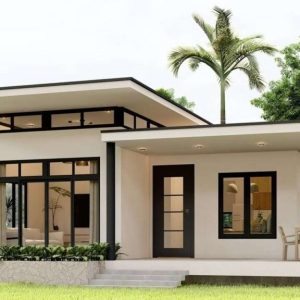
Classically designed tiny houses represent a lifestyle that focuses on a small space and eliminates unnecessary luxuries. Typically sized between 400 and 800 square feet, these homes are an economically attractive option as they are less costly and easier to maintain. It is also an environmentally friendly choice as living in small spaces increases sustainability and reduces energy consumption.
Classic tiny houses also offer variety in terms of design. They can achieve a stylish and pleasant appearance by using traditional architectural elements and details. Oftentimes, one of the highlights in tiny homes is the high ceilings, often combined with large windows. These ceilings make the interior feel more spacious and open and also allow plenty of natural light to come in.
The interior arrangement of small houses prioritizes functionality and effective use. A cleverly arranged tiny house can contain everything needed. To make the most of these spaces, foldable furniture, wall beds, and space-saving storage solutions are often preferred.
However, living in tiny houses is not limited to just reduced space. On the contrary, tiny houses provide more interaction with their natural environment and the opportunity to spend more time outdoors. Often small houses are equipped with verandas or terraces overlooking natural landscapes. In this way, while they get the chance to integrate with nature in a calm environment, they do not have to give up the spaciousness of the interior spaces.
Classically designed tiny houses also have the advantage of being mobile. Mobile tiny houses mean that you can move them at any time and position them in different places. This offers the opportunity to have different landscapes and have a variety of experiences.
Tiny houses attract the attention of families, retirees, travelers, and those living alone. They can reduce stress by adopting a simpler lifestyle for retirees while providing a cost-effective and environmentally friendly home option for young families. Likewise, travelers who are constantly traveling or relocating can always carry their living space with them by opting for mobile tiny homes.


In addition to the advantages and attractive features offered by the classically designed tiny houses, the effects of these houses on the lifestyle and social order are also remarkable. Tiny houses offer an alternative approach to consumption culture by allowing people to meet their needs with less material consumption. This can encourage people to live a less stressful and more peaceful life.


Globally, urban population growth and rising housing costs have increased the value of tiny homes. Tiny houses offer a viable solution to cope with limited spaces in city centers and accommodate more people in affordable housing. Such houses are generally cheaper to build and have lower energy consumption, promoting an eco-friendly lifestyle.
Owners of tiny houses gain skills in small space management, practical living, and simplification. The need to fit in less space with fewer belongings reduces unnecessary consumption habits and the tendency to accumulate property. This can make people focus on their needs and give more importance to intangible values.


However, living in a tiny house brings with it some challenges. Living in a small space can be boring or limiting for some people. It may also be unsuitable for families or create difficulties for the physically handicapped. In addition, some cities or communities may have legal restrictions on tiny houses or regulations that restrict use due to a lack of infrastructure.


Classically designed tiny houses can change social interaction and neighborhood relations. Tiny houses encourage people to spend more time outside and increase participation in neighborhood activities. People living in a smaller community may have a higher tendency to cooperate and help each other. Such lifestyles can contribute to people being less isolated and having healthier social bonds.








